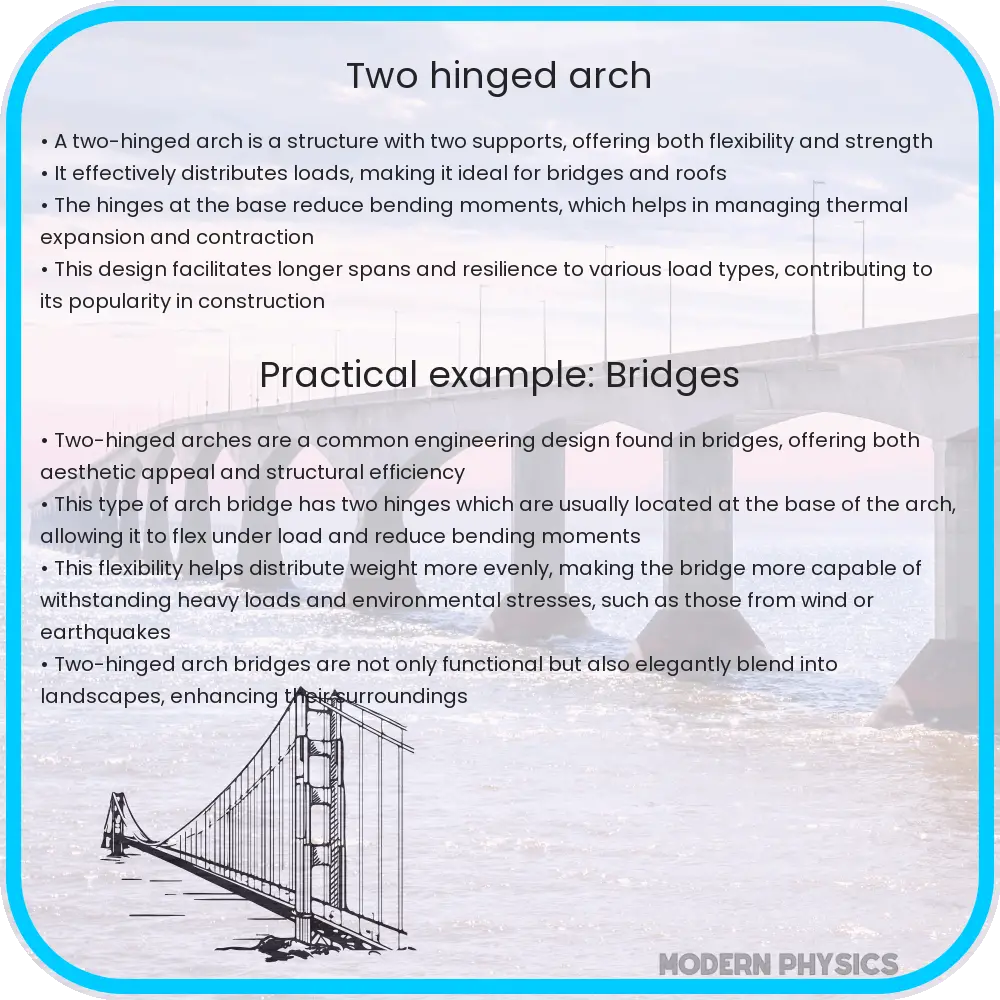Explore the stability, design, and applications of two-hinged arches in architecture, highlighting materials, force flow, and advanced engineering.

Understanding the Two-Hinged Arch: Stability and Design
The two-hinged arch represents a pivotal structure in the realm of architectural engineering, combining both aesthetic appeal and structural integrity. This arch type is distinguished by its two hinges, typically located at the base, allowing it to efficiently manage both vertical and horizontal forces. This article delves into the core principles of stability, force flow, and design considerations that govern the construction and application of two-hinged arches.
Stability and Force Flow
At the heart of a two-hinged arch’s design is its ability to offer enhanced stability. The arch’s shape naturally diverts vertical forces from the apex down to the supports at the bases, thus reducing bending moments. This force distribution is crucial in managing loads, particularly in bridges and large structures. The hinges at the bases add a degree of flexibility, allowing the arch to slightly rotate and adjust to temperature-induced expansions or contractions, a feature absent in fixed arches.
Design Principles
Designing a two-hinged arch involves a meticulous balance between aesthetics and functionality. Key considerations include:
- Material Selection: The choice of materials impacts both the weight and strength of the arch. Common materials include reinforced concrete, steel, and wood, each offering unique benefits and challenges.
- Arch Shape: The arch’s curvature, whether semicircular, parabolic, or catenary, affects load distribution and overall stability. Parabolic arches, for instance, are effective in evenly dispersing loads along the arch.
- Load Analysis: Understanding the type and magnitude of loads (live, dead, wind, etc.) is crucial for determining the arch’s dimensions and reinforcements.
Furthermore, environmental considerations, such as wind loads and seismic activity, play a vital role in the design process. For example, areas prone to high winds or earthquakes require additional considerations to ensure the arch’s stability and longevity.
In conclusion, the two-hinged arch remains a testament to engineering ingenuity, balancing elegance with functional stability. Its design principles, centered around material choice, arch shape, and load analysis, make it a versatile and robust choice for various architectural applications.
Advanced Considerations in Two-Hinged Arch Design
Advancing beyond basic design principles, two-hinged arches also necessitate a deep understanding of advanced engineering concepts. These include stress distribution, thermal expansion, and dynamic load handling. Engineers must carefully analyze how stresses are distributed across the arch, particularly in areas where tension and compression converge. Additionally, accommodating for thermal expansion is crucial in preventing structural damage over time, especially in climates with significant temperature variations.
Architectural Integration
The integration of two-hinged arches into architectural designs extends beyond mere structural considerations. Aesthetically, these arches offer a visually pleasing element that can be adapted to various architectural styles, from modern to classical. They also provide opportunities for creating expansive spaces without internal supports, a feature highly valued in large public spaces like auditoriums and train stations.
Environmental Impact and Sustainability
Today’s architectural landscape increasingly demands sustainability. Two-hinged arches contribute to this by enabling the use of eco-friendly materials and designs that reduce the overall carbon footprint. For instance, incorporating lightweight materials reduces transportation and construction energy costs, aligning with green building practices.
Technological Advancements
The evolution of technology has significantly impacted the design and construction of two-hinged arches. Computer-aided design (CAD) and 3D modeling have revolutionized the way architects and engineers visualize and refine their structures. These tools allow for precise calculations and adjustments, ensuring that the final product is both safe and aesthetically pleasing.
Conclusion
The two-hinged arch, an architectural marvel, stands as a symbol of the harmony between form and function. Its stability, facilitated by intelligent design and material selection, makes it suitable for various applications, from bridges to grand architectural projects. The integration of advanced engineering principles and environmental considerations further enhances its appeal in the modern architectural landscape. As technology continues to advance, the potential for innovative applications of two-hinged arches in architecture and engineering is boundless, promising a future where aesthetic elegance and structural integrity coexist seamlessly.
